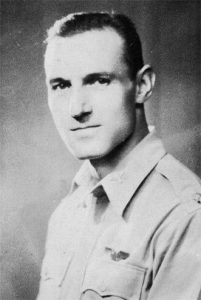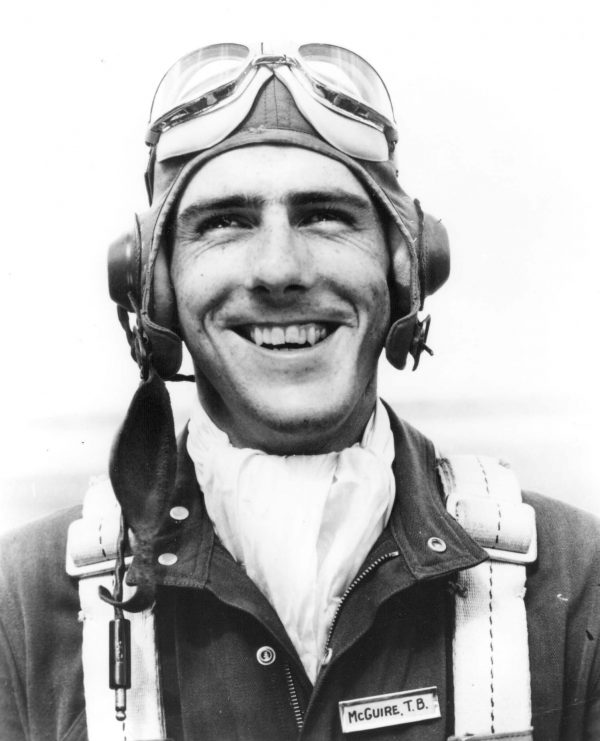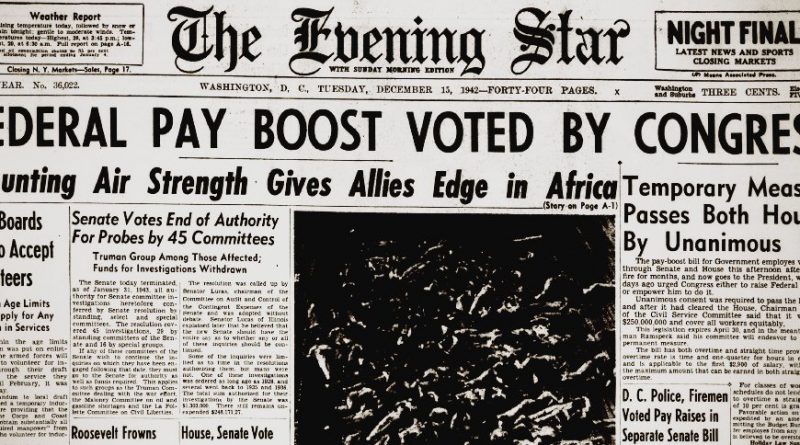World War II Chronicle: December 15, 1942
Click here for TODAY’S NEWSPAPER

Today we learn that the recent loss of the troopship SS President Coolidge may in fact have been due to our own mines… Six years ago Donald Mackay Keiser enlisted as a private. He earned the Silver Star during the Japanese attacks on Oahu, and a year later he was one of the service’s youngest colonels, having served as the Ninth Air Force’s chief of staff. Page five notes his passing… Capt. Joseph J. Foss is credited with 22 victories, making the 22-year-old Marine the top American ace to date. Story on page nine…
America’s World War II aces: where are they now?
By December 1942, Capt. Foss is the top American dogfighter, and he finishes the war as the top-scoring Marine. Looking at the guys that finished the war with 25 or more kills, only three have shot down an enemy — one of which flies for the Royal Air Force (RAF).
On Dec. 7, 1941 Francis S. “Gabby” Gabreski1 was one of the few Wheeler Field pilots able to get airborne to hunt Japanese pilots. In October 1942 the Army Air Force transferred the Polish-American captain to England where he will briefly fly Spitfires alongside other Polish pilots for 20 missions as part of the RAF’s No. 315 Polish Fighter Squadron. He is back with the Americans at the end of February, flying P-47 Thunderbolts with the 61st Fighter Squadron out of England.
Gregory Boyington2 resigned his commission as a Marine first lieutenant in 1940 to fly for the American Volunteer Group — the “Flying Tigers.” While fighting in China, he shot down two enemy fighters and destroyed 1.5 on the ground. He resigned from the Flying Tigers in April 1942 and rejoined the Marines as a major in September. Early next year he deploys to Guadalcanal as executive officer of Marine Fighter Attack Squadron 122 (VMFA-122).
2nd Lt. Robert S. Johnson3 was also assigned to the 61st FS. While Gabreski was flying Spitfires, Johnson’s squadron had the dangerous job of breaking in the first production P-47Bs at Bridgeport, Conn.. Johnson had just received orders to prepare for deployment to Europe at the beginning of the year.
Charles H. MacDonald4 was also stationed at Wheeler and patrolled for Japanese warplanes over Oahu on Dec. 7. One year later he had just been promoted to major and commands the 340th Fighter Squadron at Westover Field, Mass.
In July, 2nd Lt. George E. Preddy Jr.5 was involved in a fatal mid-air collision of two P-40 Warhawk fighters during a training mission over Australia. A wingman ran into Preddy’s plane and the two P-40s crashed into the ground, killing the second pilot. Preddy was able to parachute out of his stricken fighter and rescue crews saved the critically wounded pilot before he bled out. He is currently recovering and will ship out to Europe in July 1943.
Flight Lieutenant Lance C. Wade,6 the top American ace flying for the RAF, is currently back in the States testing fighters for the British when he’s not on war bond tours. Before crossing the Atlantic, Wade had splashed 15 enemy planes and earned two Distinguished Flying Crosses.
Robert M. Hanson7 is still an aviation cadet and is commissioned a second lieutenant in the Marine Corps in February 1943.
In September, 1st Lt. John C. Meyer8 was named commanding officer of the 34th Pursuit Squadron. The 34th had no aircraft and few personnel after fighting in the Philippines and was being reformed. Meyer and his men are in the process of being equipped with P-47s before they cross the Atlantic in May.
Lt. Cmdr. David McCampbell9 survived the sinking of the aircraft carrier USS Wasp in September and is currently a landing signal officer instructor at Naval Air Station Melbourne (Fla.).
Capt. Thomas B. McGuire Jr.10 received his commission and pilot wings in February 1942 and flew a P-39 Airacobra on patrol missions over the Aleutian Islands. He made it back to the states by December and is married before shipping out to Hamilton Field (Calif.) where he learns to fly P-38 Lightnings.

Richard I. Bong11 earned his wings one month before McGuire and future presidential candidate Capt. Barry Goldwater was one of his instructors. While learning to fly P-38s with the 49th FS at Hamilton, Bong was grounded for flying under the Golden Gate Bridge and other aerobatic stunts. His unit shipped out without him in July and he transferred to the Pacific. 2nd Lt. Bong began combat operations over New Guinea in November, but America’s future ace of aces won’t score his first victories until Dec. 27.
Sports section begins on page 16. There is a possibility that football may not be able to survive the war. The Pittsburgh Steelers, for example, have lost all but three of their players to military service and other professional football leagues that would have players to fill empty roster slots have already shut down. Next year Pittsburgh merges with the similarly depleted Philadelphia Eagles to form a team known then as the “Phil-Pitt Combine.” Today, we know them as the Phil-Pitt Steagles. These are not the only teams whose operations are drastically affected by the war: More to come as the news develops.
Roving Reporter by Ernie Pyle
WITH THE AMERICAN FORCES IN ALGERIA — When Ralph Gower was a little fellow in Arkansas, a deaf man lived across the street.
The man could read lips, and Ralph learned the trick from him. He did it mainly to show off before the other kids.
A quarter of a century has passed, and today Sgt. Ralph Gower sits on the edge of a folding cot in a tent way out in the field of Africa.
It is a hospital tent, and wounded soldiers in red bathrobes loll around in it. Ralph Gower can talk to them, and he can understand what they say, solely because he learned lip reading as a prank when he was a child. For he is newly deaf, from the explosion of an enemy shell.
When I went to see him he had been deaf only a few days, but his lip reading was already perfect. It had all come back to him across those 25 years. We talked for half an hour and he never made a single mistake.
Sergeant Gower escaped without serious wounds other than the loss of his hearing. They say there is a 50-50 chance of his recovering his hearing, but even if he doesn’t he’s got two strikes on deafness to begin with.
Ralph Gower is 37. He was born in Truman, Ark., but his home address is now Route 3, Box 832, Sacramento, Cal. He used to be a draughtsman and a machine -screw operator. He served a hitch in the Army in his early 20s, and joined up again as soon as England and Germany started fighting. He is a machine-gun sergeant.
Gower came to Africa aboard a group of combat boats that got into trouble to take an Algerian harbor. Those who lived to tell the tale were miraculously lucky.
“Do you want to hear what it felt like?” Ralph asked.
I sat down on the edge of the next cot. “Sure I Do. What did it feel like?”
“It felt just like going into hell and back out again,” he said.
The boys around the tent all laughed loudly. That startled me, for I couldn’t see anything to laugh at. But gradually I caught it.
It seems that Sergeant Gower’s deadpan Arkansas wit keeps the whole tentful howling day and night. He never says anything obviously clever. He just says things with an odd twist. He never cracks a smile. His expression never changes.
Six dozen wounded boys gathered on nearby cots to listen as Ralph told me the whole story. He told it very gravely, but he was frequently interrupted by shattering laughter from his convalescing audience. It was friendly and admiring laughter.
“We were all down in one of the compartments of the boat,” he said. “That French ship came right up against us, and one of their shells came through the side. The damn thing exploded right in my face.”
Some of the wounded soldiers in the tent had been through the same lethal nightmare he was describing, but they laughed at that crack just as though Bob Hope had said it.
“I never heard a sound,” Ralph went on. “It just went ‘shist-ppfftt.’ That’s all I ever heard. Then I passed out.
“When I came to everything was quiet. I thought the battle was over. The ship was full of ammonia and smoke. You couldn’t hardly breathe. I liked to choked to death. My heart was shooting pains out in all directions. (Laughter). I couldn’t get enough air in my lungs. I couldn’t even get enough smoke, for that was all I was getting anyhow. (More laughter).
“I finally started climbing a ladder. When I stuck my head out on deck I couldn’t hear anything, but the air was full of tracer bullets. Then I realized there were dead men lying on the deck. I passed out. That fresh air was too much for me. (Laughter).
“When I came to again I was lying over by the rail with a stack of dead men. We had a hell of a time. Them dead men wouldn’t move much. (Laughter). I thought I was never gonna get out from under there.”
Thus the story went. Censorship doesn’t permit repeating the full details.
It was getting late, and we shook hands.
“Are you married,” I asked.
“Am I married?” he said. “No, I’m single. I mean to say I’m sensible.”
The wounded boys all roared.
Sometimes you leave a battle hospital feeling horrible inside, but I stepped out of that tent, under millions of African stars, feeling good about Americans who can go “into hell and back out again” and still laugh about it.
1: Gabreski’s parents were Polish immigrants and he spoke Polish. He finished the war with 28 kills, 2.5 on the ground, and added another 6.5 in Korea.
2: Boyington (28 kills) hadn’t yet earned the nickname “Pappy.” Originally an Army coastal artillery officer after graduating Reserve Officers Training Corps in 1934, then was accepted as a Marine Corps aviation cadet.
3: Johnson had 27 kills.
4: MacDonald had 27 kills.
5: Preddy had tried three times to become a Naval aviation cadet was rejected. He achieved ace-in-a-day, five ground kills, with 26.83 aerial victories.
6: Wade finished with 25.
7: Hanson had 25.
8: Meyer had 24 in the air, 13 on the ground, and added two more in Korea.
9: McCampbell was the top Navy ace with 34, and achieved ace-in-a-day twice.
10: McGuire had 38.
11: Bong had 40.
Evening star. (Washington, D.C.), 15 December 1942. Chronicling America: Historic American Newspapers. Lib. of Congress.
https://chroniclingamerica.loc.gov/lccn/sn83045462/1942-12-15/ed-1/
